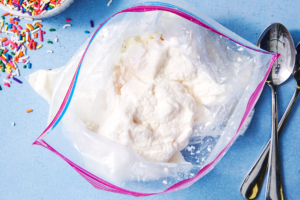Happy July! While most people associate July with Independence Day, it’s also host to some of the more interesting national holidays like National Anti-boredom Month, National Culinary Arts Month, National Grilling Month, National Hotdog Month, and National Purposeful Parenting Month. It is also the national month for everyone’s favorite frozen treat: ice cream!

Ice cream, with its rich and creamy history (pun intended), has been and continues to be one of the most sought-after cold desserts. While some forms of it have been dated back to the second century B.C., the first account of this creamy treat in the U.S. was in 1774. The first advertisement for it came in May 1777, just a year after the founding of our great nation in 1776. What was once enjoyed mainly by the elite, became more available with technological advances made in the 1800s and 1900s. Today, it’s now a common treat for the everyday person, and annually more than 6.4 billion pounds of frozen dairy are produced in the U.S.!
The story behind this sweet treat
While ice cream can get a bad rap for containing sugar, in moderation it can provide the health benefits of energy, vitamins, and minerals. Ice cream can even help prevent mood swings, living up to the stereotypical breakup coping mechanism we see in romantic comedies from time to time. According to the USDA FoodData Central database, one serving of vanilla ice cream (66g) contains 2.31g protein, 7.26g total fat, and 15.6g carbohydrate for a combined estimate of 137 kcal of energy. Not to mention, it also includes varying levels of essential vitamins and minerals including vitamin D, calcium, and some vitamin B12, which is only naturally found in animal-based proteins.

Regardless of whether your favorite flavor is vanilla, chocolate, mint chip, rocky road, or even pistachio, the first ingredient of ice cream is milk. Traditionally, families would raise milk cows to feed themselves, but now most of us buy milk from the store and may never see a cow up close. No matter where you buy your milk (or ice cream), it’s more than likely that it came from a family farm! Today, 94% of dairy farms, regardless of size, are still family-owned and operated and most have become much more sustainable over time. From just 2007 to 2017, modern dairy farms are using 21% less land, 30% less water, and 20% less fuel.
The last century brought several improvements in dairy cow genetics and production across different breeds, development and evolution of technology, and advancements in food safety such as pasteurization (heating milk quickly to kill bacteria) and homogenization (breaking up fat particles in milk to prevent separation). Dairy farms are often located near city centers to ensure that fluid milk travels from the farm to the processing plant to the grocery store in an average of two days. Where the ice cream process differs is the milk makes a pit stop at another plant responsible for making the ice cream before heading to the stores. At this ice cream plant, the milk goes through additional processes to add flavors evenly, add in fruit or mix-ins like cookie dough chunks, package, and harden before it can be shipped to the stores. From milk to ice cream, even though it is frozen, it is a fresh and safe product.
Make it at home!
We can always buy ice cream from the store or ice cream shop, but did you know you can also easily make it at home for the family?! Ice cream can be made with a machine or even by shaking the ingredients in a plastic bag. With just a few ingredients and materials, ice cream can be made by anyone at any time. Many recipes are available online and from Ag in the Classroom! A tried-and-true recipe we’ve made with various clubs or family events takes just 15 minutes:

Ingredients:
- ½ cup milk
- ½ cup half and half
- 2 tbsp sugar
- ½ tsp vanilla extract
- Toppings or mix-ins – your choice!
Materials:
- Quart-size freezer bag
- Gallon-size freezer bag
- Ice
- Rock salt, ice cream salt, or kosher salt
- Towel or paper towels (optional)
Steps:
- Prepare ingredients bag – In the quart-sized bag, add vanilla extract, sugar, half and half, and milk. Remove the air and seal the bag tightly.
- In the gallon-sized bag, fill a quarter to half full with ice. Add about ¼ cup (4 tbsps.) of rock salt.
- Place the sealed quart-sized bag with ingredients inside the gallon-size bag with the ice. Seal the gallon-sized bag.
- Hold or wrap with a towel (if you want to keep your hands from getting too cold). Shake lightly or rock the bag until ingredients harden to the desired thickness; about 10 minutes (softer = less time, thicker = more time).
(Note: You may need to add more ice and/or rock salt to keep the ingredients cold enough.)
- Open the bag and remove the ingredients bag. Scoops out into a bowl and add desired toppings or mix-ins! Enjoy!
Celebrate all month long
So, eat an ice cream (or ten) this month. Make it yourself or buy it from the store. Serve it in a cone, a bowl, or with another dessert. Try some new recipes and enjoy them during these hot summer months. If you’re up for the challenge, you can celebrate National Ice Cream Month and several other national July holidays all at once. To avoid child boredom, teach your kids the culinary art of ice cream making while the family grills some hotdogs for the Fourth of July. No matter how you choose to celebrate, you can never go wrong with ice cream in hand!
All posts are the opinion of the author and do not necessarily represent the view of the Animal Ag Alliance.







